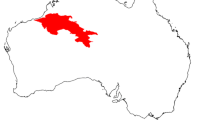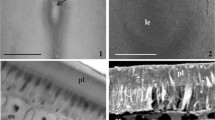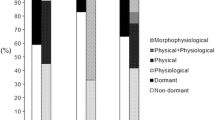Abstract
The germination ecology, including primary and secondary dormancy, mortality of seeds, and seed-bank type, of 20 fen grassland species from Northern Germany was investigated using a combination of burial and germination experiments. To analyze primary dormancy and effects of after-ripening (dry storage for 28 days) on freshly matured seeds, germination was measured at two fluctuating temperature regimes (15/25°C and 5/15°C) in the light and in darkness. Temporal changes in dormancy were investigated by burying seeds at 8–10 cm depth in nylon bags, exhuming samples at bimonthly intervals over a period of two years, and analyzing germination at the above-mentioned temperature and light treamtents. Additional seed samples were retrieved five years after burial to determine seed longeity and seed-bank type. Freshly matured seeds of all species except Bromus racemosus showed primary dormancy. Dry after-ripening significantly increased germination in Parnassia palustris and Triglochin palustre. Mortality of buried seeds of Bromus racemosus, Sanguisorba officinalis, and Succisa pratensis reached 100% within 12 months (transient seed banks). All other species germinated both in the first and in the second growth period after burial and (with the exception of Briza media) showed annual changes in dormancy. For Silene flos-cuculi and Juncus filiformis, dormancy cycles were detected only in the dark treatments. Most species had a lower percentage germination in darkness than in the light, and the greatest suppression of germination in darkness was found in the small-seeded species (Juncus filiformis and Parnassia palustris). The retrieval of seed samples after five years revealed that most of the fen grassland species examined have short-term, persistent seed banks and thus are buffered against years of poor seed production and/or seedling survival. In addition, a large proportion of the species maintain long-term, persistent seed banks from which re-establishment is possible if management practices and site conditions of degenerated fen grasslands become appropriate following restoration measures.
Similar content being viewed by others
Literature Cited
Bakker, J. P. 1989. Nature Management by Grazing and Cutting. Geobotany 14:1–397.
Baskin, C. C. and J. M. Baskin. 1998. Seeds: Ecology, Biogeography and Evolution of Dormancy and Germination. Academic Press, San Diego, CA, USA.
Baskin, C. C., E. W. Chester, and J. M. Baskin, 1996. Effect of flooding on annual dormancy cycles in buried seeds of two wetland Carex species. Wetlands 16:84–88.
Baskin, J. M. and C. C. Baskin. 1985. The annual dormancy cycle in buried weed seeds: a continuum. BioScience 35:492–498.
Baskin, J. M. and C. C. Baskin. 1988. Germination ecophysiology of herbaceous plant species in a temperate region. American Journal of Botany 75:286–305.
Baskin, J. M. and C. C. Baskin. 1989. Physiology of dormancy and germination in relation to seed bank ecology. p. 53–66. In M. A. Leck, V. T. Parker, and R. L. Simpson (eds.) Ecology of Soil Seed Banks. Academic Press, San Diego, CA, USA.
Bekker, R. M., G. L. Verweij, R. E. N. Smith, R. Reine, J. P. Bakker, and S. Sneider. 1997. Soil seed banks in European grasslands: does land use affect regeneration perspectives? Journal of Applied Ecology 34:1293–1310.
Bekker, R. M., J. H. J. Schminee, J. P. Bakker, and K. Thompson. 1998. Seed bank characteristics of Dutch plant communities. Acta Botanica Neerlandica 47:15–26.
Bernhardt, K. G. 1994. Vegetation und Diasporenbanken van Kalkflachmooren und Kalksümpfen. Untersuchungen zum Samenpotential im Kanton St. Gallen (Schweiz). Naturschutz und Landschaftsplanung 26:13–20.
Bigwood, D. W. and D. W. Inouye. 1988. Spatial pattern analysis of seed banks: an improved method and optimized sampling. Ecology 69:497–507.
Drückhammer, A. and S. Wriedt. 1996. Die Samenbank unterschiedlicher Feuchtgrünland-Gesellschaften Schleswig-Holsteins und ihre Bedeutung für den Artenschutz. Feddes Repertorium 107: 243–261.
Ekstam, B. and A. Forseby. 1999. Germination response of Phragmites australis and Typha angustifolia to diurnal fluctuations in temperature. Seed Science Research 9:157–163.
Falinska, K. 1999. Seed bank dynamics in abandoned maedows during a 20-year period in the Bialowieza National Park. Journal of Ecology 87:461–475.
Grime, J. P., G. Mason, A. V. Curtis, J. Rodman, S. R. Band, M. A. G. Mowforth A. M. Neal, and S. Shaw. 1981. A comparative study of germination characteristics in a local flora. Journal of Ecology 69:1017–1059.
Hurlbert, S. H. 1984. Pseudoreplication and the design of ecological field experiments. Ecological Monographs 54:187–211.
Jensen, K. 1998. Species composition of soil seed bank and seed rain of abandoned wet meadows and their relation to the aboveground vegetation. Flora 193:345–359.
Karrssen, C. M. 1982. Seasonal patterns in dormancy in weed seeds. p. 243–270. In A. A. Khan (ed.) The Physiology and Biochemistry of Seed Development, Dormancy and Germination. Elsevier, Amsterdam, The Netherlands.
Keddy, P. A. and A. A. Reznicek. 1982. The role of seed banks in the persistence of Ontario’s coastal plain flora. American Journal of Botany 69:13–22.
Maas, D. 1989. Germination characteristics of some plant species from calcareous fens in southern Germany and their implications for the seed bank. Holarctic Ecology, 12:337–344.
Maas, D. and A. Schopp-Gluth. 1995. Seed banks in fen areas and their potential use in restoration ecology. p. 189–206. In B. D. Wheeler, S. C. Shaw, W. J. Fojt and R. A. Robertson (eds.) Restoration of Temperate Wetlands. Wiley & Sons, Chichester, UK.
McDonald, A. W., J. P. Bakker, and K. Vegelin. 1996. Seed bank classification and its importance for the restoration of species-rich flood-meadows. Journal of Vegetation Science 7:157–164.
Mierwald, U. and J. Beller. 1990. Rote Liste der Farn- und Blütenpflanzen Schleswig-Holsteins. Landesamt Naturschutz und Landschaftspflege Schleswig-Holstein: 1–64.
Mika, V. 1978. Der Vorrat an keimfähigen Samen in südböhmischen Niedermoorböden. Zeitschrift für Acker- und Pflanzenbau 146: 222–234.
Milberg, P. 1994. Annual dark dormancy cycle in buried seeds of Lychnis flos-cuculi. Annales Botanicae Fennici 31:163–167.
Milberg, P., L. Andersson, and K. Thompson. 2000. Large-seeded species are less dependent on light for germination than smallseeded ones. Seed Science Research 10:99–104.
Morrison, D. A. and E. C. Morris 2000. Pseudoreplication in experimental designs for the manipulation of seed germination treatments. Austral Ecology 25:292–296.
Murdoch, A. J. and R. H. Ellis. 2000. Dormancy, viability and longevity. p. 193–229. In M. Fenner (ed.) Seeds. The Ecology of Regeneration in Plant Communities. 2nd edition CABI International. Wallingford, UK.
Olff, H., D. M. Pegtel, J. M. Van Groenendael, and J. P. Bakker 1994. Germination strategies during grassland succession. Journal of Ecology 82:69–77.
Patzelt, A., U. Wild, and J. Pfadenhauer. 2001. Restoration of wet fen meadows by topsoil removal: vegetation development and germination biology of fen species. Restoration Ecology 9:127–136.
Pfadenhauer, J. and D. Maas. 1987. Samenpotential von Niedermoorböden des Alpenvorlandes bei Grünlandnutzung unterschiedlicher Intensität. Flora 179:85–97.
Pons, T. L. 1989. Breaking of seed dormancy by nitrate as a gap detection mechanism. Annals of Botany 63:139–143.
Pons, T. J. 1991. Dormancy, germination and mortality of seeds in a chalk-grassland flora. Journal of Ecology 79:765–780.
Poschlod, P. 1993. Die Dauerhaftigkeit von generativen Diasporenbanken in Böden am Beispiel von Kalkmagerrasenpflanzen und deren Bedeutung für den botanischen Arten- und Biotopschutz. Verhandlungen der Gesellschaft für Ökologie 22:229–240.
Probert, R. J. 2000. The role of temperature in the regulation of seed dormancy and germination. p. 261–292. In M. Fenner (ed.) Seeds. The Ecology of Regeneration in Plant Communities, 2nd edition. CABI International, Wallingford, UK.
Roberts, H. A. and P. M. Feast. 1973. Changes in the numbers of viable weed seeds in soil under different regimes. Weed Research 13:298–303.
Schütz, W. 1997. Primary dormancy and annual dormancy cycles in seeds of six temperate wetland sedges. Aquatic Botany 59:75–85.
Schütz, W. 1998. Seed dormancy cycles and germination phenologies in sedges (Carex) from various habitats. Wetlands 18:288–297.
Schütz, W. 1999. Germination responses of temperate Carex-species to diurnally fluctuating temperatures—a comparative study. Flora 194:21–32.
Schütz, W. and P. Milberg. 1997. Seed dormancy in Carex canescens: regional differences and ecological consequences. Oikos 78: 420–428.
Statsoft, 2001. Statistica for Windows, Version 6.0. Statsoft Inc, Tulsa, OK, USA.
ter Borg, S. J. T. 1985. Population biology and habitat relations of some hemiparasitic Scrophulariaceae. p. 463–485. In J. White (ed.) The Population Structure of Vegetation. Junk Publishers. Dordrecht, The Netherlands.
Thompson, K. and J. P. Grime. 1983. A comparative study of germination responses to diurnally fluctuating temperatures. Journal of Applied Ecology 20:141–156.
Thompson, K., J. P. Bakker, and R. M. Bekker. 1997. The Soil Seed Banks of North West Europe: Methodology, Density and Longevity. Cambridge University Press, Cambridge, UK.
van der Valk, A. G. and J. T. A. Verhoeven. 1988. Potential role of seed banks and understorey species in restoring quaking fens from floating forests. Vegetatio 76:3–13.
Wagner, M., P. Poschlod, and R. P. Setchfield. 2003. Soil seed bank in managed and abandoned semi-natural meadows in Soomaa National Park, Estonia. Annales Botanici Fennici 40:87–100.
Werner, P. A. and W. J. Platt. 1976. Ecological relationships of cooccurring goldenrods (Solidago: Compositae). American Naturalist 110:959–971.
Wesson, G. and P. F. Warreing. 1969. The role of light in the germination of naturally occurring populations of buried weed seeds. Journal of Experimantal Botany 20:402–413.
Wheeler, B. D. 1995. Introduction: Restoration and Wetlands. p. 1–19. In B. D. Wheeler, S. C. Shaw, W. J. Foijt, and R. A. Robertson (eds.) Restoration of Temperate Wetlands, Wiley & Sons, Chichester, UK.
Wisskirchen, R. and H. Haeupler 1998. Standardliste der Farn- und Blütenpflanzen Deutschlands. Ulmer, Stuttgart, Germany.
Author information
Authors and Affiliations
Rights and permissions
About this article
Cite this article
Jensen, K. Dormancy patterns, germination ecology, and seed-bank types of twenty temperate fen grassland species. Wetlands 24, 152–166 (2004). https://doi.org/10.1672/0277-5212(2004)024[0152:DPGEAS]2.0.CO;2
Received:
Revised:
Accepted:
Issue Date:
DOI: https://doi.org/10.1672/0277-5212(2004)024[0152:DPGEAS]2.0.CO;2




